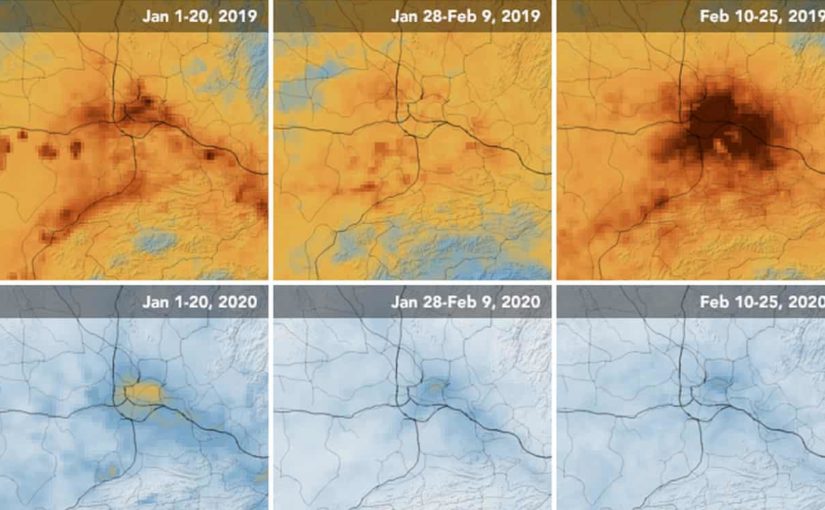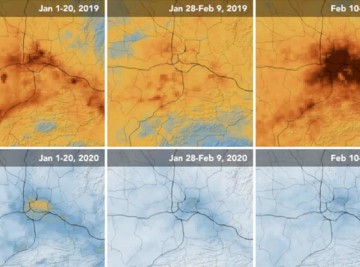Unintended Environment benefits of Corona
Wow, to our surprise, In Delhi, the often murky, sewage black water, foul-smelling Yamuna recently began to get clearer, with stones visible in the water below. A few days back, there was a flood of reports on social media about the pictures of Dhauladhar mountain ranges in Himachal Pradesh clearly visible from Jalandhar, a city of Punjab. Indian Civets are seen on the road of Kerala, nilgai is seen near a mall in Noida, Delhites can enjoy the clear sky at night, and haze-free days and clean green trees, many Delhites must have seen the star at night after decades, and many more such videos and images started surfacing. India’s efforts to limit the coronavirus meant the absence of pollution in the city and in the whole country.
Industrial operations in India has come to halt because of coronavirus and travel restrictions within the country meant that air, rail and road traffic was paused completely.
India has seen the emergence of Coronavirus at the end of January 2020, fortunately, it spread very slowly and in the first week of April this has reached to a number of around 4700, though this small number could be because of the very less number of tests India has done so far. India started its isolation from the rest of the world in the third week of march but because of population density, with extreme economic disparity in the society, it’s not possible to quarantine the whole population.
Italy’s effort to limit Coronavirus meant the absence of boat traffic on Venice’s famous waterways. Fish can be seen in the water below and it appears that everything is coming to life again.
In fact, all the countries who have been under strict lockdown to stop the spread of Coronavirus have unintended benefitted from it and see the dramatic improvement in the countries’ environmental conditions. If not in full, at least in part, the pandemic has contributed to a noticeable drop in greenhouse gas emissions in some countries.
The same has happened in Wuhan, China, Coronavirus first emerged in December 2019, it rapidly spread into the neighboring regions, the Chinese government locked down the city, isolated the city from the other part of the country and world, close to 10 million people were quarantined.
On March 8, when Italy saw a sharp increase in the number of cases, Italy locked down its northern Lombardy region. Two days later, the prime minister decided to quarantine entire Italy. This resulted in a sharp decrease in Nitrogen dioxide and Air pollution levels in Italy.
Pollution monitoring satellite operated by the European space agency and NASA released a satellite picture, in this, it can be seen that the sharp decrease in air pollution is observed and the cloud of Nitrogen dioxide that was parked over China in January seemed to evaporate in February. Similar emission reduction has been observed from other countries during economic disruption. satellite images show that temporary measures can also drive a significant decrease in harmful emissions.
Carbon dioxide is one of the most harmful gases for the environment and its emission is mainly tied to industrial activity, transportation and electricity production, anything that affects those sectors will surely impact greenhouse gases emission.
Experts warned that observed reductions are temporary and that as cities, countries, and economies bounce back, so, too, will emissions — unless major infrastructure or societal changes are adopted.
“This is the first time I have seen such a dramatic drop-off over such a wide area for a specific event,” Fei Liu, an air quality researcher at NASA’s Goddard Space Flight Center said in his statement.
Jacqueline Klopp, co-director of the Center for Sustainable Urban Development at Columbia University in New York City said, “People were in their homes and really stopped a lot of the activities that lead to greenhouse gas emissions and other pollution,”.
“As we move to restart these economies, we need to use this moment to think about what we value,” she said. “Do we want to go back to the status quo, or do we want to tackle these big structural problems and restructure our economy and reduce emissions and pollution?”


Very well written. Makes you think, but World does not go back , but certainly we need to cut down on unnecessary use of natural resources and also find processes for sustainable environment